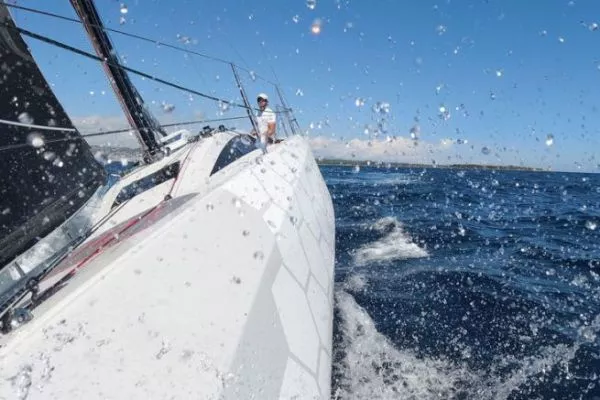Sailing upwind can be both thrilling and demanding. Here are four practical tips for increasing speed and efficiency during races or leisurely cruises.
While a strong wind can make sailing challenging, proper technique will help achieve a faster pace and ensure a more enjoyable experience on the water. Understanding how to balance sails, stabilize heel, and navigate through waves is essential for enhancing sailing performance.
Understanding Speed Dynamics
In any wind condition, speed must be prioritized before charting a course, especially when sailing upwind. The key to this is ensuring that the sails are trimmed correctly for medium wind conditions, allowing the yacht to harness the wind’s full power efficiently. Additionally, it’s crucial to recognize that passing waves can slow the boat down considerably. The question is: how do sailors maintain speed while heading upwind?
Starting with a smaller headsail is advisable, and both sails should be kept as flat as possible. Various adjustments, including backstay, trim, and halyards, must be taut. When trimming in a breeze, it’s essential not to tighten the sails as much as one would under normal wind conditions. Begin with relatively loose sails to allow the boat to gain momentum before gradually tightening them as needed. When steering becomes challenging due to consistent heel and speed, slight adjustments to the trimming may be necessary.
Balancing the Sails
For optimal performance, both the jib and mainsail must be unfurled evenly and simultaneously. A frequent mistake is to let the jib become over-trimmed while relying solely on the mainsail for balance. The headsail trimmer should keep an eye on how the jib interacts with the mainsail. If the mainsail is fully in the wind, adjustments to jib settings are crucial. For instance, moving the genoa traveller sheave backward (or up and outwards when using a 3D system) will flatten the jib while twisting its upper section.
To ensure the sails unfurl together, it’s advisable to ease the jib sheet slightly. This adjustment allows the lower half of the mainsail more flexibility in the wind, which helps reduce drag during the sailing process. Continuous slamming of the mainsail leads to undesired drift and can hinder speed.
In stormy conditions, opening both sails at the same time becomes more essential. The trimmer needs to watch reference points, such as lodging and pennons, to make real-time adjustments. If the helmsman is frequently moving toward the wind’s point to manage heel, it’s time to adjust the sails to reduce pressure.
Maintaining Consistent Angle of Heel
The primary goal for both the helmsman and trimmer is to manage a stable angle of heel. It’s unnecessary to monitor pennons in overpowered conditions; instead, the helmsman should allow the boat to ride into the wind alongside the trimmer who makes necessary sail adjustments.
An excessive angle of heel creates too much pressure on the helm, while a too-flat position can result in inadequate speed to overcome the waves. Monohulls are particularly sensitive to even slight deviations in heel angle, making it vital to cut down moderately on sail pressure to obtain an extra boost.
Patience is crucial when waiting for acceleration after adjustments. If speed doesn’t increase, it may be beneficial to ease the sails slightly and restart the process.
Navigating Through Waves
A common approach to overcoming waves involves luffing up on the ridge and crashing into the troughs, which works well in ocean swell sailing or dinghy sailing. However, when sailing upwind against shorter, more abrupt waves, speed and control are key allies.
Instead of just dropping the sails or trying to avoid large waves, managing speed and heel is paramount when approaching significant waves. Lowering sail pressure before each wave allows for better control during the crossing. In this moment, even a slight increase in speed from, say, 6.1 knots to 6.6 knots can make a positive difference, allowing the boat to rise effectively over waves.
Avoid navigating too flatly over waves, as this often results in a jarring impact that can impede speed. The reality is that hitting waves is inevitable; therefore, approaching them with speed and manageable heel predisposes the boat to sail flatter into calmer waters thereafter.
Conclusão
Mastering the nuances of sailing upwind requires practice and skill, but by adopting these tips, sailors can enhance their experience, whether racing or enjoying a leisurely cruise. As GetBoat.com continually keeps an eye on developments in sailing and seaside vacations, it understands the importance of enjoying freedom and the ocean’s beauty. The platform values enabling people to find vessels that fit their preferences, budget, and style.
Why Rent a Boat?
Experiencing new locations through boating is a multifaceted adventure, offering insights into local cultures, stunning natural landscapes, and a palate of local colors. If you’re planning your next trip to the sea, consider renting a boat, as every bay, inlet, and lagoon reveals the essence of a region just as much as its cuisine, architecture, and language. For excellent choices, take a look at GetBoat.com.
In summary, learning to navigate the nuances of sailing, especially in challenging upwind conditions, is vital for both seasoned sailors and beginners alike. Keep in mind, each sailing adventure opens doorways to unique experiences, reinforcing why GetBoat.com is the go-to platform for seamless boat rentals, fostering transparency and convenience for those looking for unforgettable sea experiences.


